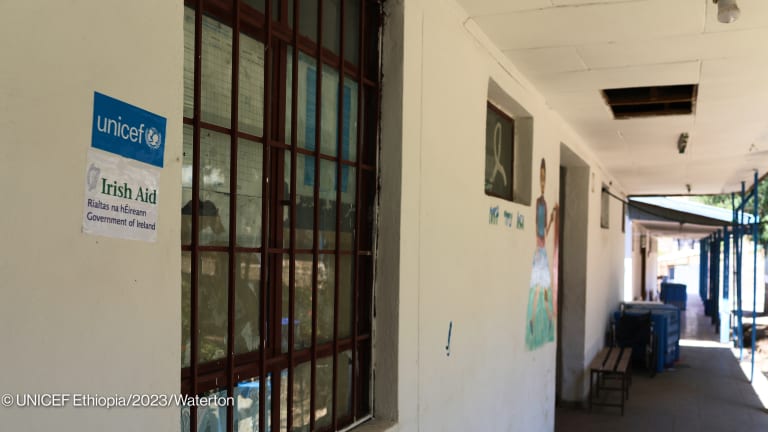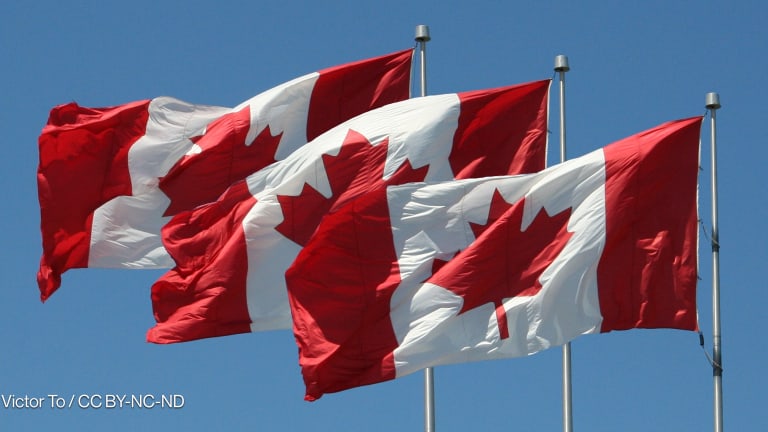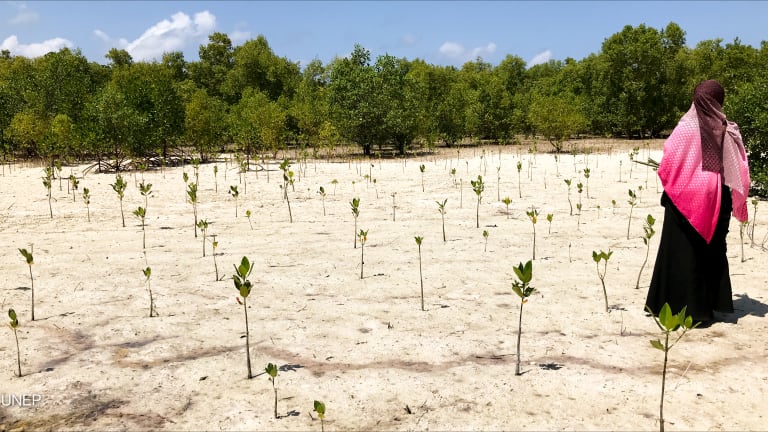Nearly $450 billion was spent on the SDGs — where did it go?
In 2022, official sources spent $441 billion, while the private sector provided $62.4 billion. But which among the SDGs received the largest share and how was the money disbursed geographically?
Devex has reported extensively on the importance of accurate and usable data in global development. Not only does it promote transparency and accountability among donors, but it also helps local players carry out development and social projects more effectively. Although many donors share project-level information on their aid spending, they often present the data without differentiating development from nondevelopment activities. The Total Official Support for Sustainable Development task force aims to address this gap by collecting and reporting the resources spent to support the Sustainable Development Goals. In this analysis, we looked into the most recent data to see how much was spent on the SDGs in 2022. All figures are in 2022 U.S. dollar constant prices, which allows for real-term year-on-year comparisons. The TOSSD data gets updated regularly, which might explain some slight differences in the figures from this piece. What is TOSSD? Last year, we published a lengthy article explaining TOSSD — from the ins and outs to key trends from 2019 to 2021. Simply, TOSSD tracks the portion of official development assistance that supports the SDGs in low- and middle-income countries. It also looks into other flows where its sustainability test shows they contribute to sustainable development. This includes “south-south cooperation” and international public goods. The resources are classified into two pillars: • Pillar one tracks the resources to one or more identifiable recipient countries. • Pillar two includes those that contribute to sustainable development where it benefits the entire world or a large part of the world, rather than just particular countries. TOSSD also tracks the amount mobilized by the private sector separately to avoid inflating the figures from official sources. How much money was spent to support the SDGs in 2022? Overall, more than $441 billion was disbursed in 2022 to support the SDGs — $314.4 billion was reported under pillar one and $126.9 billion under pillar two. This represents a 15.2% real-term increase in official sources from 2021, worth $58.2 billion. A further $62.4 billion came from private mobilization — up $14.2 billion, or 29.6%, from 2021. As noted in our previous analysis, the increase is partly due to more countries reporting to TOSSD. It does not necessarily mean higher spending from donors. According to the TOSSD task force, 119 bilateral and multilateral respondents provided data for the 2022 report — nine respondents more than the previous year. Which among the SDGs got the biggest share? Projects typically have multiple objectives, which is why mapping out how much exactly went to each SDG remains a difficult task. For instance, an education project could have gender and health components. Hence, TOSSD data analyzes two categories: official resources that went only to one SDG, and official resources that had multiple targets. The same top three SDGs prioritized in 2021 were the biggest recipients in 2022. SDG 17 — partnerships to achieve the goals — ranked first. A total of 6.7% of single target resources were committed to this SDG. And 4.5% of multiple target resources included this among their targets. This was followed by SDG 3 on good health and well-being, with 5.9% of the resources indicating it as a sole priority. Among those with multiple targets, 6.5% included SDG 3. SDG 7 on affordable and clean energy accounted for 3.9% of the total resources, while 3.6% of those with multiple targets had it as a component. A total of 38% of flows were classified as “not marked,” which means that no SDG target was reported. This is a significant improvement from 2021, which had 45% of resources with unspecified targets. What were the sectoral priorities? The TOSSD data is also presented by sector, which follows OECD’s DAC CRS code list and the International Standard Industrial Classification of All Economic Activities, or ISIC, classification. Based on the data, humanitarian aid maintained its rank from the previous year, receiving $47.9 billion, or 10.9% of the total official sources — up $6.9 billion, or 16.9%, from 2021. Another $5.6 million was mobilized by private counterparts. Syria was the primary recipient of humanitarian aid, with $6.6 billion. Other top recipients were Afghanistan, with $4 billion; Ukraine, with $3.9 billion; and Yemen, with $2.5 billion. Meanwhile, $4.6 billion was spent on humanitarian aid in multiple countries from different regions, which OECD labels as “developing countries, unspecified.” Activities in the government and civil society sector were also prioritized, receiving $45.2 billion — 36.6% more than the previous year. A further $57.6 million was mobilized by the private sector. The top recipients were Ukraine, with $11.6 billion; Indonesia, with $1.7 billion; and Pakistan, with $1.1 billion. Another $3.7 billion was spent in multiple countries from different regions and nearly $1.8 billion on global activities. Health ranked next, with $40.7 billion — 10.1% higher than in 2021. Private providers spent another $1.3 billion on health-related activities. The bulk went to activities in multiple countries — $5.1 billion from official sources and $82.5 million from the private sector. About $4.4 billion went to global health activities. India was the top recipient among countries, with $3.5 billion through official channels and $555.9 million through private mobilization. <div class='tableauPlaceholder' id='viz1713152768506' style='position: relative'><noscript><a href='#'><img alt='Dashboard 1 ' src='https://public.tableau.com/static/images/Se/SectoraldistributionofTOSSDin2022/Dashboard1/1_rss.png' style='border: none' /></a></noscript><object class='tableauViz' style='display:none;'><param name='host_url' value='https%3A%2F%2Fpublic.tableau.com%2F' /> <param name='embed_code_version' value='3' /> <param name='site_root' value='' /><param name='name' value='SectoraldistributionofTOSSDin2022/Dashboard1' /><param name='tabs' value='no' /><param name='toolbar' value='no' /><param name='static_image' value='https://public.tableau.com/static/images/Se/SectoraldistributionofTOSSDin2022/Dashboard1/1.png' /> <param name='animate_transition' value='yes' /><param name='display_static_image' value='yes' /><param name='display_spinner' value='yes' /><param name='display_overlay' value='yes' /><param name='display_count' value='yes' /><param name='showShareOptions' value='false' /></object></div> <script type='text/javascript'> var divElement = document.getElementById('viz1713152768506'); var vizElement = divElement.getElementsByTagName('object')[0]; if ( divElement.offsetWidth > 800 ) { vizElement.style.width='580px';vizElement.style.height='425px';} else if ( divElement.offsetWidth > 500 ) { vizElement.style.width='580px';vizElement.style.height='425px';} else { vizElement.style.width='100%';vizElement.style.height='700px';} var scriptElement = document.createElement('script'); scriptElement.src = 'https://public.tableau.com/javascripts/api/viz_v1.js'; vizElement.parentNode.insertBefore(scriptElement, vizElement); </script> <i style=font-style: georgia;”>Sectoral distribution of TOSSD based on TOSSD data.</I> How was the money spent geographically? The largest portion of money from official sources went to activities with multiple recipient countries from different regions, worth $81.7 billion — $14.9 billion under pillar one and $66.8 billion under pillar two. This is $9.5 billion, or 13.1%, more than the previous year. A further $4.1 billion came from private providers. Another $41.4 billion was spent on global projects — a significant increase from the $17.6 billion disbursement in 2021. <div class='tableauPlaceholder' id='viz1713109455869' style='position: relative'><noscript><a href='#'><img alt='Dashboard 1 ' src='https://public.tableau.com/static/images/Ge/GeographicaldistributionofTOSSD/Dashboard1/1_rss.png' style='border: none' /></a></noscript><object class='tableauViz' style='display:none;'><param name='host_url' value='https%3A%2F%2Fpublic.tableau.com%2F' /> <param name='embed_code_version' value='3' /> <param name='site_root' value='' /><param name='name' value='GeographicaldistributionofTOSSD/Dashboard1' /><param name='tabs' value='no' /><param name='toolbar' value='no' /><param name='static_image' value='https://public.tableau.com/static/images/Ge/GeographicaldistributionofTOSSD/Dashboard1/1.png' /> <param name='animate_transition' value='yes' /><param name='display_static_image' value='yes' /><param name='display_spinner' value='yes' /><param name='display_overlay' value='yes' /><param name='display_count' value='yes' /><param name='showShareOptions' value='false' /></object></div> <script type='text/javascript'> var divElement = document.getElementById('viz1713109455869'); var vizElement = divElement.getElementsByTagName('object')[0]; if ( divElement.offsetWidth > 800 ) { vizElement.style.width='580px';vizElement.style.minHeight='850px';vizElement.style.maxHeight='1500px';vizElement.style.height=(divElement.offsetWidth*0.75)+'px';} else if ( divElement.offsetWidth > 500 ) { vizElement.style.width='580px';vizElement.style.minHeight='850px';vizElement.style.maxHeight='1500px';vizElement.style.height=(divElement.offsetWidth*0.75)+'px';} else { vizElement.style.width='100%';vizElement.style.height='1050px';} var scriptElement = document.createElement('script'); scriptElement.src = 'https://public.tableau.com/javascripts/api/viz_v1.js'; vizElement.parentNode.insertBefore(scriptElement, vizElement); </script> <i style=font-style: georgia;”>Geographical distribution of TOSSD based on TOSSD data.</I> Ukraine emerged as the top recipient among countries, with $33.6 billion — a massive jump from the $4.5 billion it received in 2021. This was largely driven by large allocation to three sectors: government and civil society, with $11.6 billion; commodity aid, with $9 billion; and humanitarian aid, with $3.9 billion. Aside from official sources, Ukraine also received $342.4 million through private mobilization. India ranked next, with $15.8 billion — 7.5% more than the previous year. Then Egypt, with $13.6 billion — flat from 2021. Other high-ranking recipients include Bangladesh, with $10.4 billion; Indonesia, with $8.1 billion; and Syria, with $7.6 billion. Try out Devex Pro Funding today with a free five-day trial, and explore funding opportunities from over 850 sources in addition to our analysis and news content.
Devex has reported extensively on the importance of accurate and usable data in global development.
Not only does it promote transparency and accountability among donors, but it also helps local players carry out development and social projects more effectively.
Although many donors share project-level information on their aid spending, they often present the data without differentiating development from nondevelopment activities.
This story is forDevex Promembers
Unlock this story now with a 15-day free trial of Devex Pro.
With a Devex Pro subscription you'll get access to deeper analysis and exclusive insights from our reporters and analysts.
Start my free trialRequest a group subscription Printing articles to share with others is a breach of our terms and conditions and copyright policy. Please use the sharing options on the left side of the article. Devex Pro members may share up to 10 articles per month using the Pro share tool ( ).
Miguel Tamonan is a Senior Development Analyst at Devex, where he analyzes data from public and private donors to produce content and special reports for Pro and Pro Funding readers. He has a bachelor’s degree in Political Science with a Major in International Relations from the Polytechnic University of the Philippines.








